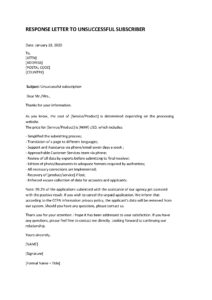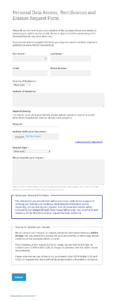Utilizing a pre-defined structure streamlines the process for both the individual making the request and the organization processing it. This reduces ambiguity, minimizes back-and-forth communication, and helps ensure compliance with relevant data protection regulations. Standardized forms can also improve internal efficiency by providing a consistent framework for handling these requests.
This article will further explore the practical applications, legal context, and best practices associated with facilitating individual data rights requests. Specific examples and implementation guidance will be provided to offer a comprehensive understanding of this crucial aspect of data governance.
Key Components of a Data Subject Request Form
Effective data subject request forms contain essential elements that facilitate clear communication and efficient processing. These components ensure individuals can easily articulate their requests while enabling organizations to respond accurately and promptly.
1: Requestor Identification: Clear fields for the individual’s full name, contact information, and any identifying numbers (e.g., customer ID, account number) are crucial for verifying the requestor’s identity and associating the request with the correct data.
2: Specific Request Type: Options should be provided to specify the desired action, such as accessing, rectifying, erasing, restricting processing, or obtaining a copy of the data. Clear descriptions of each request type aid comprehension and prevent ambiguity.
3: Data Specification: The form should include space for the individual to specify the particular data the request pertains to. This may involve describing the data categories, date ranges, or specific documents.
4: Request Justification (Optional): While not always mandatory, a field for providing context or justification for the request can be helpful. This can assist the organization in understanding the request’s background and processing it more effectively.
5: Authorization and Verification: Mechanisms for confirming the requestor’s identity, such as signature fields or authentication procedures, should be incorporated to prevent unauthorized access to personal data.
6: Date of Request: Including a field for the date of the request is essential for tracking purposes and ensuring timely processing within regulatory deadlines.
7: Submission Instructions: Clear instructions on how to submit the completed form, including available submission methods (e.g., email, postal mail, online portal) and relevant contact information, are crucial for seamless processing.
A well-designed form incorporates these components to ensure clarity, efficiency, and compliance in handling data subject requests, fostering trust and transparency in data processing practices.
How to Create a Data Subject Request Template
Developing a robust template requires careful consideration of legal requirements and practical usability. A well-structured form facilitates efficient processing and ensures compliance with data protection regulations. The following steps outline the creation process.
1: Identify Legal Requirements: Applicable data protection legislation (e.g., GDPR, CCPA) dictates specific requirements for handling data subject requests. Templates must align with these obligations to ensure legal compliance.
2: Determine Required Fields: Essential information for processing requests includes requestor identification, contact details, the specific request type, and details about the data in question. These fields form the core of the template.
3: Design for Clarity and Accessibility: Forms should employ clear language, logical organization, and accessible formatting. Simple instructions and unambiguous field labels enhance user comprehension.
4: Incorporate Verification Mechanisms: Implement methods for verifying the identity of the requestor to prevent unauthorized data access. This may include signature fields, authentication processes, or other security measures.
5: Establish Submission Methods: Provide multiple submission channels (e.g., online portal, email, postal mail) to cater to diverse preferences and ensure accessibility.
6: Test and Refine: Thorough testing with representative users identifies potential usability issues and ensures the template functions effectively. Regular reviews and updates maintain relevance and efficacy.
7: Document and Train: Maintain comprehensive documentation explaining the template’s purpose, usage, and associated procedures. Training staff on proper handling of data subject requests ensures consistent and compliant processing.
A comprehensive template, incorporating these elements, ensures efficient handling of data subject requests, streamlines workflows, and promotes organizational compliance with data protection regulations. Regular review and adaptation to evolving legal and operational landscapes are crucial for maintaining effectiveness.
Standardized forms for data subject requests serve as a critical component of a robust data governance framework. They facilitate the exercise of individual rights regarding personal information, ensuring compliance with data protection regulations while streamlining communication between individuals and organizations. Effective implementation requires careful consideration of legal obligations, user experience, and internal processes.
Organizations must prioritize the development and maintenance of clear, accessible, and legally compliant mechanisms for handling data subject requests. This proactive approach strengthens data protection practices, fosters trust with individuals, and contributes to a more responsible and transparent data ecosystem. Continual adaptation to evolving regulatory landscapes and technological advancements remains essential for maintaining effective data governance strategies.


